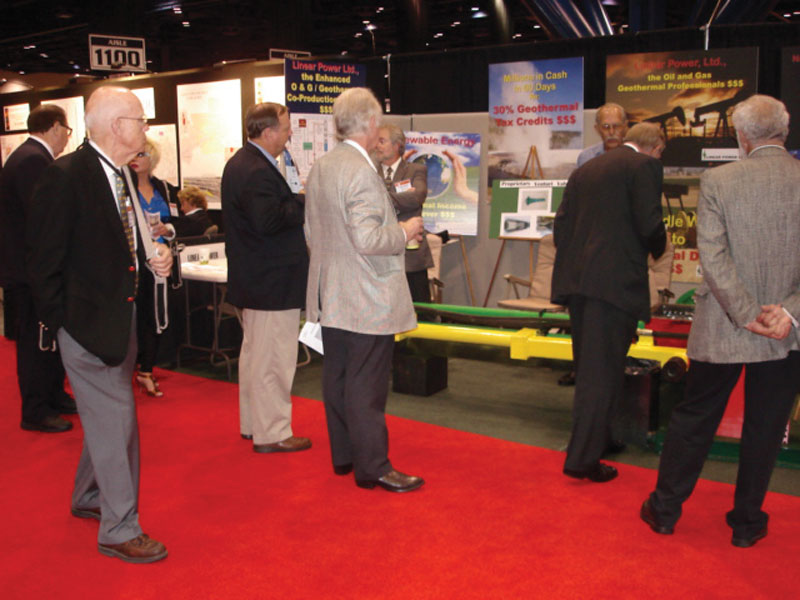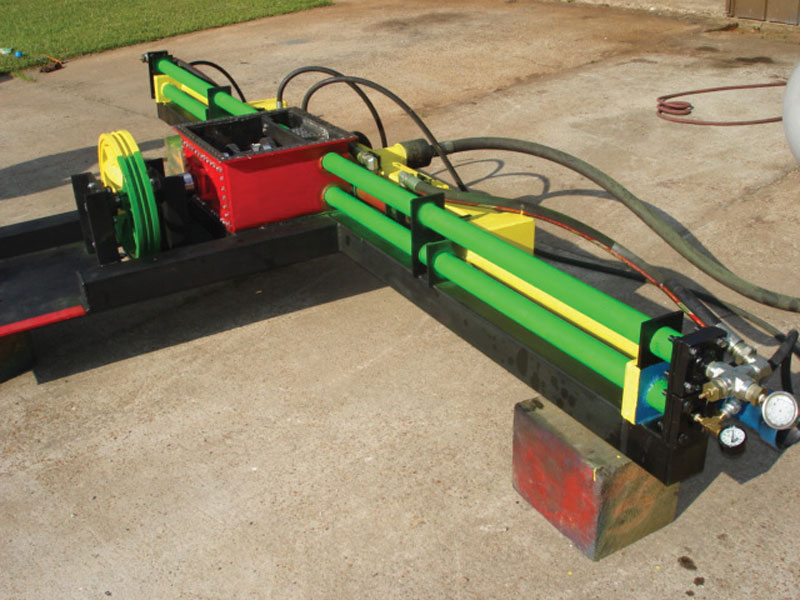Thinking outside the box: One surprise at the recent summer NAPE was a linear driver free-piston engine that can turn watered-out wells into long-life electrical power producers.

Summer NAPE crowds gathered to see the Linear Driver Free-Piston engine.
How very appropriate that Houston is home to Summer NAPE.
The enormous demand for air-conditioning required to make life bearable in this Gulf Coast city’s environment of excessive summer heat and humidity is apt testimony to the nation’s need for dependable energy sources – particularly time-proven, efficient oil and natural gas.
Summer NAPE is the annual prospect and property exhibition, offered by AAPG and the American Association of Professional Landmen – a companion to the NAPE event held earlier in the year. Both events have become “must attend” events for geologists, geoscientists and investors.
The delightfully chilled George R. Brown Convention Center enabled the recent NAPE viewers to roam in comfort as they perused the expected smorgasbord of oil and gas drilling prospects.
Of course, they also came across vendor booths where the unexpected was on display.
Included among the surprise encounters this year was Long Beach, Mississippi-based Linear Power Ltd., which was displaying the Linear Driver Free-Piston Engine it developed to turn watered-out wells into long-life electrical power producers.
“Natural gas wells that produce gas, or geo-pressured brine/gas wells that produce mainly high pressure brine, or low pressure gas wells with a high water cut are all wells capable of generating kinetic energy,” said Bob Hunt, founder and chief technology officer at Linear Power. “This energy in turn is able to produce valuable amounts of electricity.
“A highly productive well is capable of producing several megawatts of electricity per hour,” Hunt said. “A megawatt (MW) per hour of electricity will sell in a range of $75 to $120 per hour, resulting in revenues of up to $86,000 per month.
“The economics of individual well locations will vary depending on selling price and other factors,” he emphasized.
The electricity produced can either be used on site or sold into a local electrical distribution grid.
“Our application is attractive to oil and gas producers who spend significant amounts of money on electricity for production purposes,” Hunt noted.
Step by Step
Linear Power has performed short-term testing of its equipment on wells in the field, and it has purchased five wells in Mississippi’s Hancock County that are candidates for the technology. The wells are conveniently sited 12 miles from Linear’s manufacturing facility.
At the time of this purchase, central Louisiana-based Cleco Corp. got wind of Linear’s technology and contacted Hunt upon a recommendation from SMU. Via a relationship created by Cleco, Linear entered into an arrangement with ICON Environmental Services involving five high-pressured wells owned by ICON in Port Allen, La.
When Linear applied for a $7 million grant from the DOE – which required at least five wells – it ended up with 10 in the package.
The company is planning its first commercial project on the Port Allen wells.
“The wells are 12,000 feet deep, 300 degrees and have 7,000 psi, so they’re highly overpressured,” Hunt said.
“These are stripper wells with a lot of very high pressure hot water,” he noted. “We’ll be able to produce both kinetic energy from the pressure and thermal energy from the heat, so we have two renewable energy sources within the wells and enhanced oil and gas coproduction via continuous gas-lift of the wells.
“We should be able to produce 10 megawatts of electrical power per well,” Hunt predicted, “and 50 megawatts is a very sizeable power plant. At only 10 megawatts, you’re getting into the half million dollar per month range.”
The site is a mere half-mile from a substation, and Linear is completing an agreement with Cleco to take the power.
Hunt anticipates the project will be fully functional during 2010, with parts of it in play perhaps this year.
How It Works

The engine that turns watered-out wells into long-life electrical power producers.
Here’s the blueprint.
The installation of the Linear Driver at the wellhead is completely non-invasive. The continuous flow of high-pressure gases and/or liquids through the engine delivers continuous force in order to produce direct generation of AC or DC power.
This occurs through the connection of the power output rod to a “linear-motion-to-rotary-motion” conversion transmission via a 90-degree perfect vector angle that provides maximum power transfer in order to drive a standard rotary electrical alternator.
To kick off the process, a coiled tubing stringer is placed in the well, and the operator injects a liquid phase working fluid, such as CO2 , propane, ethane, etc.
“When it shoots into the well at depth, it turns into gas,” Hunt said. “What causes it to go to gas is it boils using the heat energy of the well, so that’s the geothermal.
“Then the gas lifts the well, so it creates co-production of oil and gas recovery along with geothermal energy and kinetic energy because the total flow of the gas created in the well, the water within the well and the natural gas and oil all comes and runs through our machine and turns into power,” Hunt explained.
“When the liquid changes phase from liquid to gas, it expands to a lot bigger volume,” he said, “so now that volume drives a piston and creates energy.
“We cool the gas by blowing air over it and it turns back to the liquid phase, and we pump it back into the well in a closed cycle,” Hunt added.
He said the process is referred to as the Organic Rankine Cycle, often called a binary cycle. It differs from a binary cycle, however, in that they use the wellbore as a boiler.
“What makes it so powerful is the water,” Hunt said. “Most binary cycles only produce gas by indirect heat exchange at the surface.”
He expanded on this process based on the formula for kinetic energy: Kinetic Energy = one-half mass times velocity2.
In other words, the faster water travels the more velocity it has, and the velocity is squared in the formula. So as the velocity increases, the power increases.
“You have high mass water that’s accelerated by the gas to high velocity,” Hunt said, “so you get an enormous amount of power that the normal binary cycle without water doesn’t perform.
“The binary cycle is modified in that we’re injecting into hot water deep within the wellbore, which accomplishes direct heat exchange,” he said, “and getting gas lift of the total flow of high velocity water and gas back to our unit to drive it, along with valuable natural gas and oil co-production.
“It’s a unique cycle,” Hunt said, “and a unique piece of equipment.”